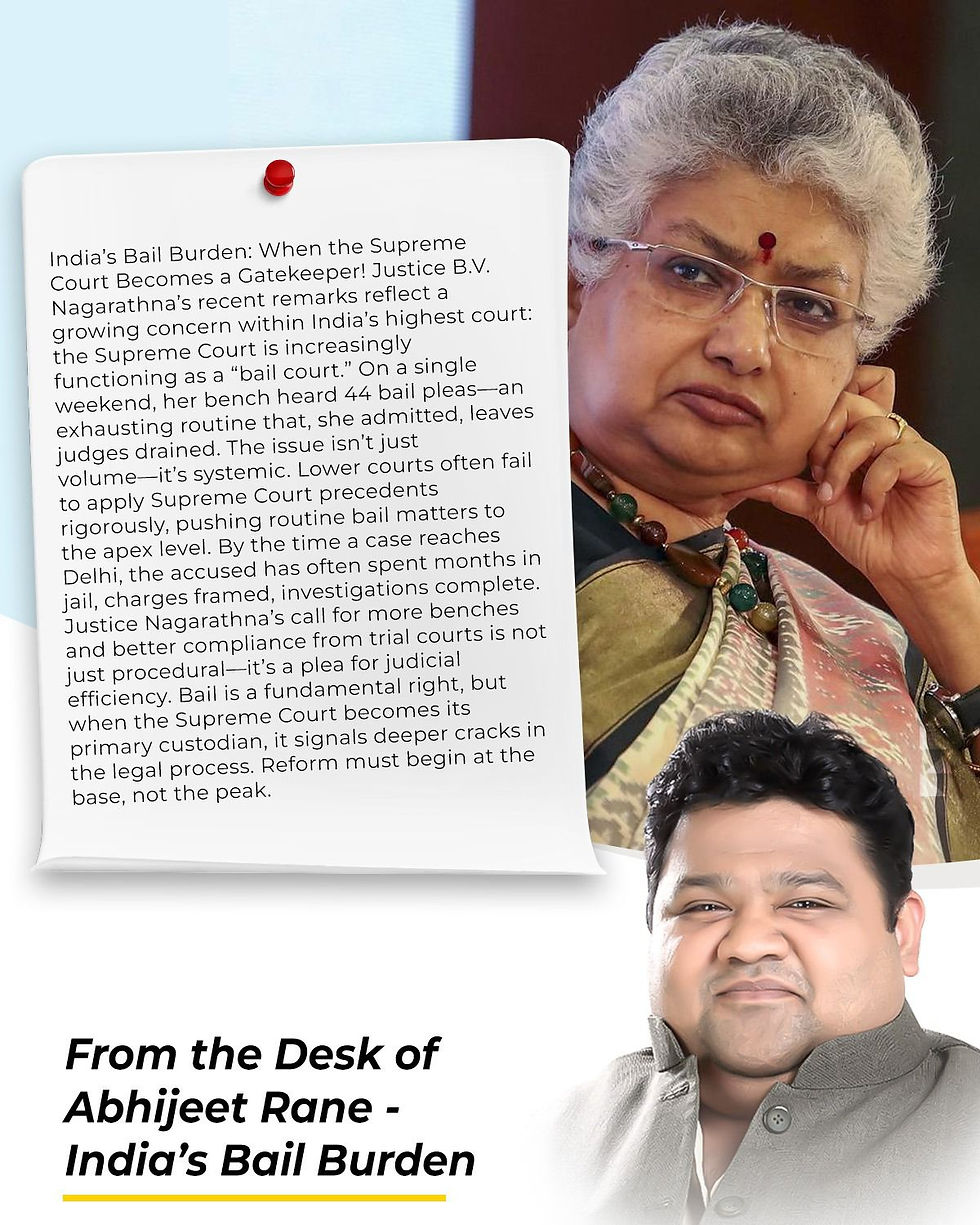From The Desk of Abhijeet Rane
- dhadakkamgarunion0
- Sep 25
- 3 min read
From The Desk of Abhijeet Rane
From BIMARU to Benchmark: Uttar Pradesh’s Fiscal Leap! Once dismissed as a ‘BIMARU’ state, Uttar Pradesh has now emerged as India’s top revenue-surplus performer. According to the latest CAG report, UP recorded a staggering ₹37,000 crore surplus in FY 2022–23—outpacing 15 other states including Gujarat, Odisha, and Karnataka. This turnaround is credited to Chief Minister Yogi Adityanath’s policy focus and the momentum of a double-engine government. With tax collections projected to quadruple since 2012, and the state budget expected to cross ₹8 lakh crore by 2025–26, UP is not just stabilizing its economy—it’s setting a precedent. In contrast, 12 states including Maharashtra, Kerala, and Punjab are grappling with revenue deficits totaling ₹2.22 lakh crore. UP’s fiscal discipline, rising GSDP, and efficient spending make it a case study in transformation. The message is clear: economic revival is possible, even for states once written off.
From The Desk of Abhijeet Rane
Empowering the Maratha Youth: A Felicitation Rooted in Reform! On the 92nd birth anniversary of Annasaheb Patil, Chief Minister Devendra Fadnavis will be felicitated by the Annasaheb Patil Economic Development Corporation for his sustained efforts toward uplifting the Maratha community. Corporation Chairman Narendra Patil highlighted that under Fadnavis’s leadership, over ₹13,250 crore in loans have been disbursed to 1.5 lakh Maratha entrepreneurs—transforming youth into business leaders. From a modest ₹50 crore allocation during the Congress-NCP era to a proposed ₹750 crore in the upcoming budget, the growth in financial support reflects a shift from tokenism to tangible empowerment. Critics point to past neglect, but the current administration’s focus on entrepreneurship, interest subsidies, and institutional trust has created a new economic pathway for Maratha youth. This felicitation isn’t just ceremonial—it’s a recognition of policy-driven change and a tribute to Annasaheb Patil’s vision of inclusive progress.
From The Desk of Abhijeet Rane
India’s Bail Burden: When the Supreme Court Becomes a Gatekeeper! Justice B.V. Nagarathna’s recent remarks reflect a growing concern within India’s highest court: the Supreme Court is increasingly functioning as a “bail court.” On a single weekend, her bench heard 44 bail pleas—an exhausting routine that, she admitted, leaves judges drained. The issue isn’t just volume—it’s systemic. Lower courts often fail to apply Supreme Court precedents rigorously, pushing routine bail matters to the apex level. By the time a case reaches Delhi, the accused has often spent months in jail, charges framed, investigations complete. Justice Nagarathna’s call for more benches and better compliance from trial courts is not just procedural—it’s a plea for judicial efficiency. Bail is a fundamental right, but when the Supreme Court becomes its primary custodian, it signals deeper cracks in the legal process. Reform must begin at the base, not the peak.
From The Desk of Abhijeet Rane
India’s Bail Burden: When the Supreme Court Becomes a Gatekeeper! Justice B.V. Nagarathna’s recent remarks reflect a growing concern within India’s highest court: the Supreme Court is increasingly functioning as a “bail court.” On a single weekend, her bench heard 44 bail pleas—an exhausting routine that, she admitted, leaves judges drained. The issue isn’t just volume—it’s systemic. Lower courts often fail to apply Supreme Court precedents rigorously, pushing routine bail matters to the apex level. By the time a case reaches Delhi, the accused has often spent months in jail, charges framed, investigations complete. Justice Nagarathna’s call for more benches and better compliance from trial courts is not just procedural—it’s a plea for judicial efficiency. Bail is a fundamental right, but when the Supreme Court becomes its primary custodian, it signals deeper cracks in the legal process. Reform must begin at the base, not the peak.
From The Desk of Abhijeet Rane
Justice for Jay Valvi: A Silent Protest Turned Tragic! What began as a silent march demanding justice for Jay Valvi, a young tribal man fatally attacked in Nandurbar, ended in chaos. On September 24, hundreds gathered peacefully at the District Collector’s office, mourning Jay’s death and urging swift legal action against the accused, Suryakant Marathe. But the protest took a violent turn when miscreants vandalized vehicles and clashed with police. Stone-pelting ensued, forcing law enforcement to resort to lathi-charge and tear gas. Several officers and social activist Malti Valvi were injured. The tribal community’s grief is real, and their demand for justice is valid. But violence dilutes the moral force of their cause. Jay’s death must not be buried under broken glass and scattered stones—it must echo in courtrooms, not in chaos. The state must ensure accountability, and society must protect the dignity of protest.











Comments